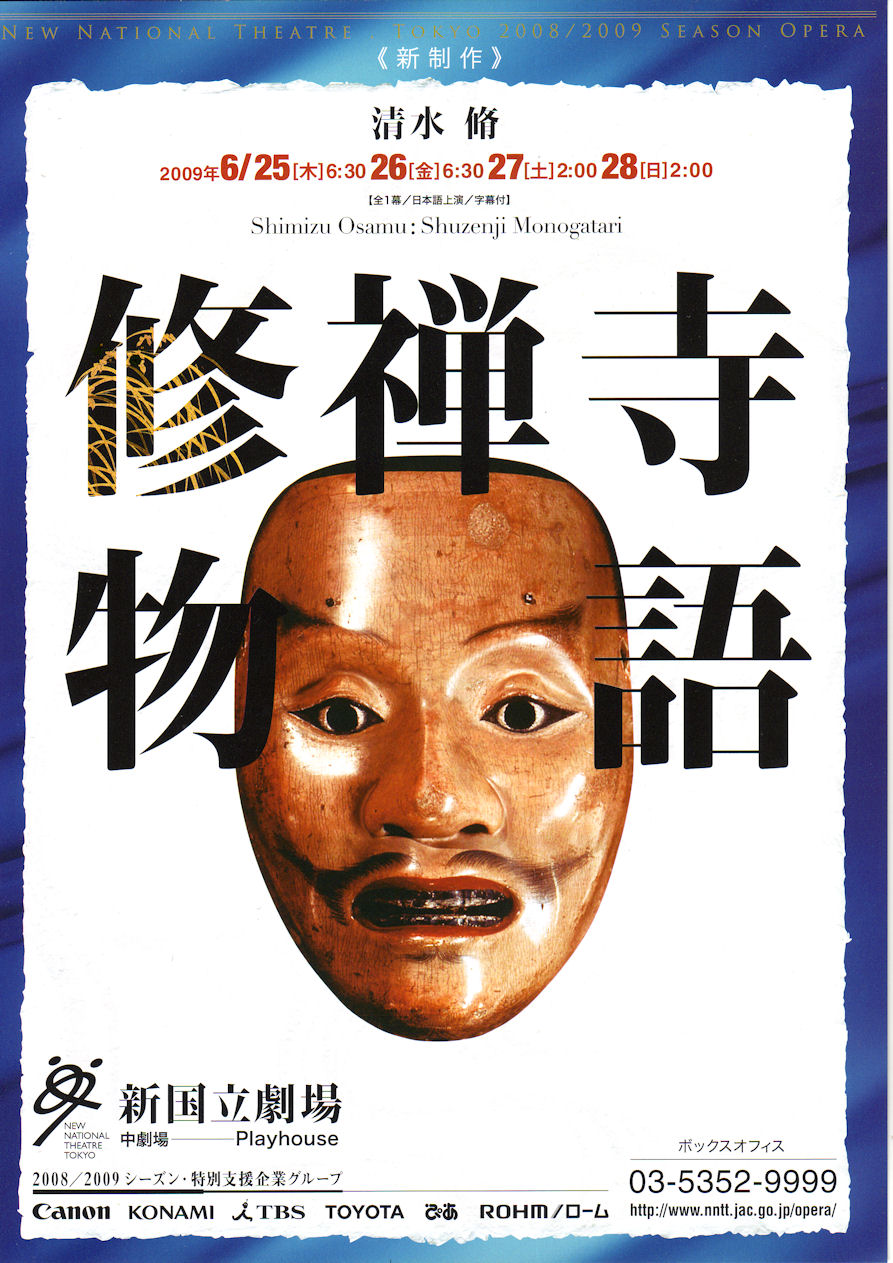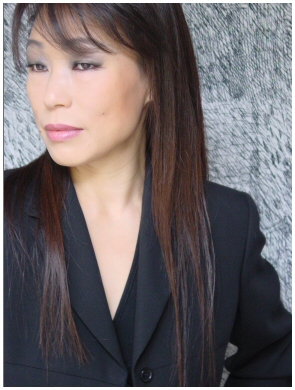Wednesday, September 2, 2009
MUSIC TODAY 21: Part II
Ligeti – San Francisco Polyphony for Orchestra: I love most of his work, and this piece was no exception. The opening sounds evoked images of fog and mist that surround San Francisco Bay in the early morning. Then, colorful tone clusters delighted the ears (at least mine at any rate).
Webern – Five Pieces for Orchestra, op. 10: One of the masterpieces of the Second Viennese School. Very tricky to give a good performance of these atonal miniatures, but the orchestra pulled it off.
Chin - Rocaná: Wow! Sanskrit for “Room of Light”, this piece really bowled me over. The orchestra played blocks of sound over the fascinating rhythms being pumped out a very noisy (and large) percussion section. Reminded me a little of Ligeti’s “Atmospheres”, which makes sense since she studied under him in Hamburg.
Kang – Catena pour grand orchestre: Another of Chin’s teachers, but I’m afraid the pupil may have surpassed him. Catena (Latin for chain) was a little similar to the Ligeti, and Chin’s Rocaná, but less interesting. Sounded like something composed during the mid-seventies (which it was).
Chin – Su, concerto for Chinese sheng and orchestra: Composed in 2009, and commissioned by Suntory Hall, this piece was a little disappointing. Knowing nothing about it, I was curious to hear (and see) the sheng, but the writing didn’t show us much. It sounded like a reedy harmonica. The soloist, Wei Wu, gave it his all and seemed breathless by the end of it, but I still have no idea what the sheng really sounds like.
All in all, a great concert. Chin is a composer I’d like to explore further. Her opera, Alice in Wonderland, is out on DVD. From the clips I’ve seen on Youtube, it looks and sounds pretty interesting. Perhaps I’ll pick up a copy…
Tuesday, September 1, 2009
MUSIC TODAY 21: Part I
So it was with some excitement that I attended two concerts at Tokyo’s Suntory Hall last week. The first, conducted by Ryusuke Numajiri, featured pieces by Italian Salvatore Sciarrino, American Augusta Read Thomas, Briton Luke Bedford, and Hungarian Peter Eötvös.
Sciarrino – 4 Adagi per flauto dolce e orchestra: A kind of concerto for recorder. A very quiet piece. The many silent spaces gave it an eerie feeling at times. A little bit like movie music, but in a good way. The soloist (Toshiya Suzuki) gave a passionate performance.
Thomas – Violin Concerto “Juggler in Paradise”: The best piece on the program. Soloist Eiichi Chijiiwa seemed a little uncomfortable in the more romantic passages, but was rhythmically precise as he juggled a melody over the orchestra’s more fragmented accompaniment. I’d love to hear another performance that had been given more rehearsal time.
Bedford – Wreathe for orchestra: The repeated theme (I counted at least seven) passed around by various solo players was great, but didn’t develop all that much. That being said, the orchestration was exciting. (However, the poor contrabass clarinetist didn’t have much fun fighting with his instrument in the quiet passages. Must have been a rental.) Would love to here more from this young composer.
Eötvös – Konzert für zwei Klaviere und Orchester: Great performance by the two pianists, but I’m still not sure why two were needed (same goes for the two tubas). The music was very energetic and lively, but felt lacking in organization and purpose. Noisy and virtuosic, but ultimately pointless. But I may be wrong.
I’ll discuss the second concert in a future post.
Saturday, August 22, 2009
Goodbye Maestro Wakasugi, Hello...?

With the recent passing of conductor Hiroshi Wakasugi (right), the Tokyo Opera Palace has hired a new artistic director, Tadaaki Otaka. Wakasugi was lauded for bringing some modern works to the Tokyo stage (Zimmerman’s Die Soldaten was performed last year to positive reviews), but it has to be said that the Opera was far from cutting edge under his tenure. The previous director, Austrian Thomas Novohradsky, had intended to bring some excitement to the conservative institution, but had a troublesome time dealing with the Tokyo government bureaucrats who oversee the Opera’s budget. According to gossip, they would routinely veto any daring and adventurous production ideas, and be inflexible in regard to the system of booking talent (only two years in advance as opposed to the usual three, making it difficult to have the top talent come to Tokyo).
Hopefully Otaka has the nerve to stand up to the red tape, and move the opera in a bold new direction. Although Wakasugi was hardly radical, he did have some progressive ideas. It was his idea to include at least one opera by a Japanese composer in the season. He also wanted to bring some exciting European opera directors to Tokyo. He claimed to not have been a fan of modern stage productions (sex and violence, gulp), but felt it was a trend that shouldn’t be ignored.
Tokyo doesn’t have a stellar reputation for opera. But with the money it charges for tickets (among the most expensive in the world), it should. It seems that in an effort to appeal to the widest audience, the Opera Palace has opted for a conservative approach to programming. Every year sees traditional productions of La Traviata, Carmen, and other warhorses. Of course, that isn’t necessarily a bad thing. (I remember seeing Franco Zeffirelli’s Aida in New York: a true masterpiece of stagecraft.) But a chance is being missed here to present newer works or hire young directors. While the influence of Japanese artists is felt around the world, it has little effect on the world of art music here in Tokyo. It would seem a natural fit to ask some of them to bring their ideas to Tokyo’s opera stage.Just imagine if Takashi Murakami designed the stage for the Magic Flute!
Come on Maestro Otaka, let’s see some vision…

Thursday, August 13, 2009
When Opera Meets Kabuki

Quick: name three Japanese composers. A few of the more adventurous music lovers among us might come up with Toru Takemitsu, but that’s about it. There are, of course, many, and the reason for their obscurity is a question worth exploring. What can’t be denied, however, is that classical music is huge in Japan, and its capital, Tokyo, is one the best places in the world to listen to it.
Two things must be said about the Tokyo classical music scene; it’s exciting and expensive. Ignoring the latter for the moment, the number of concerts is a classical music fans’ dream come true. Orchestral concerts (7 professional orchestras!), recitals, and operas are performed in and around Tokyo almost every day. The city can also boast an impressive list of international artists stopping over for a few performances. (Wagner’s Ring Cycle played by Daniel Barenboim and the Berlin Staatsoper during their 2002 visit being a personal favorite.)
Surprisingly, even Tokyo rarely bothers to present music from Japanese composers. That being said, the New National Theater, the city’s excellent opera house, recently staged an opera by Osamu Shimizu (1911-1986), Shuzenji Monogatari (Tales from Shuzenji Temple). Based on a famous kabuki play, it tells the story of a famous mask maker troubled by a project to make a mask for a powerful and feared local samurai. Here’s the lowdown on the production.
STORY: Great. Without going into too much detail (synopsis can be found here) there was much to think about. In particular, the scene where the mask maker realizes his masks are foreshadowing the samurai’s death. He sings about his genius while his daughter lay dying. It was riveting. The end was also moving. The mask maker, having always desired to capture the expression of a dying girl, sets down to sketch his daughters face.
MUSIC: Not bad, but not great. Sounded a little like movie music. Strangely, there was nothing that identified it as “Japanese”. A missed chance I would have thought, but perhaps that was the point; avoid any obvious connection to the kabuki origin. Too bad, it would have been nice to hear some Japanese percussion or winds to create some much needed atmosphere. The Tokyo Symphony Orchestra played wonderfully (they always do), and the singing was generally strong.
SETS & COSTUMES: Pretty good. Traditional Japanese house (polished wood, tatami, etc...) in the first act. A bridge by a river started the second. The costumes, again traditional, were also well done.
STAGING: Meh. Pretty underwhelming, which was odd as a famous kabuki actor, Sakata Tojuro, was the director. The singers spent a lot of time sitting in a straight line at stage front. The one action packed scene, a fight where the assassins try to kill the samurai, wasn’t terribly exciting either. Sakata has a long connection with the play, and maybe someone with more knowledge of its performance history would have a different reaction than mine. I won’t say it was boring, but it was static.
So, that was my first experience of Japanese opera. I can’t say I loved it, but it was interesting. My wife and I are both eager to see a kabuki performance of the story, and compare the two.
I should also mention that the New National Theatre should be proud of their excellent opera company, and I hope to post some stuff about the operas from last season: Das Rheingold, Die Walkure, Lady Macbeth of Mtsensk, and La Cenerentola in the near future.




